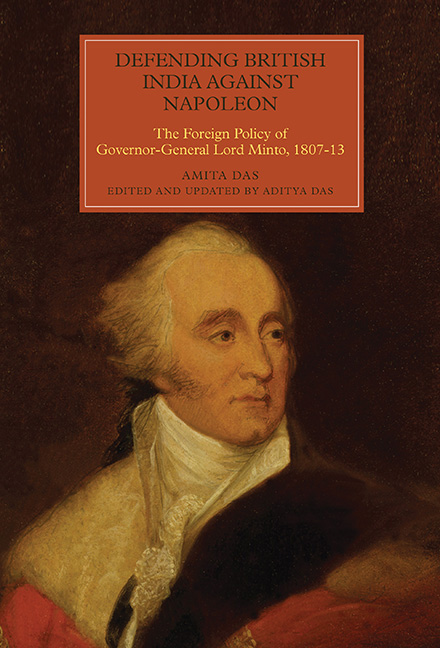Book contents
- Frontmatter
- Dedication
- Contents
- List of Illustrations
- Preface
- Abbreviations
- Chapter 1 Setting the Stage
- Chapter 2 Positioning in Persia
- Chapter 3 Creating a Buffer Zone
- Chapter 4 Protecting Trade and Supply Lines
- Chapter 5 Pre-empting French Influence in Java
- Chapter 6 Legacy of Lord Minto
- Appendix Government of the East India Company
- Bibliography
- Index
- Worlds of the East India Company
Chapter 5 - Pre-empting French Influence in Java
Published online by Cambridge University Press: 11 May 2021
- Frontmatter
- Dedication
- Contents
- List of Illustrations
- Preface
- Abbreviations
- Chapter 1 Setting the Stage
- Chapter 2 Positioning in Persia
- Chapter 3 Creating a Buffer Zone
- Chapter 4 Protecting Trade and Supply Lines
- Chapter 5 Pre-empting French Influence in Java
- Chapter 6 Legacy of Lord Minto
- Appendix Government of the East India Company
- Bibliography
- Index
- Worlds of the East India Company
Summary
Minto and the Dutch East Indies
Java became a French colony in July 1810. After the fall of L’Ile de France (Mauritius) it was the only colony where the Tricolour flag was still flying. Everywhere else in the world French sovereignty had been eliminated, except in Europe where Napoleonic influence was all encompassing. The frontiers of France stretched from the outskirts of Hamburg in the north to Naples in the south. Austria and Prussia were allies. Only Britain, Portugal, the islands of Sardinia and Sicily, tiny Montenegro on the Adriatic and disillusioned Russia were at odds with the French emperor. However, there was no fighting anywhere except in Spain. Java had become French after Holland was annexed to France after the abdication of King Louis. As the lone outpost among the Indonesian islands not occupied by the British, it was clearly threatened.
In order to continue the global battle against Napoleon, British policy was compelled to examine specific areas of Europe as well. The most sensitive areas in British eyes were the Low Countries in general and the Scheldt estuary in particular. French control of Holland meant a permanent threat to George III's Hanoverian electorate, a danger that materialised in 1803 and expanded Napoleon's influence over northern Germany. It also gave the French access to the Dutch colonial empire, particularly the East Indies and at the Cape of Good Hope from where France could challenge British dominance in India and damage trade links with the East.
Despite the strong interest in the regions mentioned, Britain's main strategic effort in 1808 onward was centred on the Iberian Peninsula. Supporting the Peninsular revolt meant that the French emperor lost the use of Spain's navy and the refuge, repair and building facilities provided by the assorted Spanish ports. A further bonus was the elimination of five French ships of the line that had been sheltering in Cadiz since Trafalgar and another one in the port of Vigo; these in turn surrendered to the Spaniards in June 1808. After the isolated French troops in Portugal had been removed, Britain liberated those Portuguese warships not secured in 1807 and also could secure eight Russian ships of the line sheltering in the Tagus while on their voyage from the Mediterranean to the Baltic and could gain the use of important Atlantic ports such as Lisbon and Oporto.
- Type
- Chapter
- Information
- Defending British India against NapoleonThe Foreign Policy of Governor-General Lord Minto, 1807-13, pp. 171 - 222Publisher: Boydell & BrewerPrint publication year: 2016



